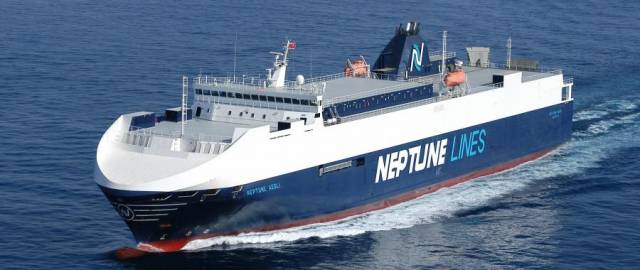#Charter -A Maltese flagged Greek owned vehicle-carrier only vessel is on charter to an Irish Sea ferry operator while its ships take refit dry-docking turns in the UK, writes Jehan Ashmore.
The chartered-in Neptune Aegli can handle 1,800 cars or 1,550 lane metres of truck/trailers has begun a first sailing today for P&O Ferries. This involved an afternoon crossing from Dublin to Liverpool.
Neptune Lines operates a fleet of 16 Pure Car & Truck Vehicle Carriers (PCTC) from which Neptune Aegli joins P&O’s European Endeavour and ropax Norbay. Noting sister, Norbank this morning entered a dry dock at Cammell Laird, Birkenhead. The shipyard and marine engineering facility located on the Wirral Peninsula is opposite to Liverpool Docks.
It is a year ago when Afloat reported on the charter to P&O of Neptune Aegli. On this current charter, the 2002 built PCTC had docked in Dublin yesterday having assisted P&O operations on the North Sea. This saw the ship provide freight support relief duties for Hull-Zeebrugge ferries sisters, Pride of York and Pride of Bruges that underwent multi-million career-extension refits.
The annual refits of the North Sea 32,000 tonnes sisters took place in Gdansk, Poland, where work on the near 900 passenger each cruiseferry involved overhauls of shops, catering experience outlets and cabins and bars will now have hotspot wi-fi. In addition the extensive upgrade was carried out throughout facilities for freight customers on the UK-Belgium route.
Pride of York when launched from Govan Shipbuilders on the Clyde as Norsea in 1986 was the largest ever passenger ship built in the UK since Cunard Line’s Queen Elizabeth dating to 1969.
The famous trans-Atlantic ocean liner had too been built on the banks of the Clyde but from the John Brown yard.































































